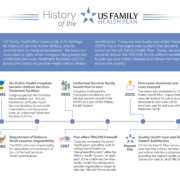Congress is one step closer to a makeover of the Military Health System (MHS) and TRICARE that will feature the model of care, values and performance objectives already provided by the US Family Health Plan.
In the recently-passed conference bill and report on the National Defense Authorization Act for Fiscal Year 2017 (NDAA), Congress establishes objectives and expectations for improving military health care beginning in 2018, focusing on quality, value-based care and an improved experience and access to care for beneficiaries. Specifically, in the report Congress calls for the Department of Defense (DOD) to pursue several strategic improvements to military health services, including:
- Improved access to health care
- Improved health outcomes
- Improved quality of health care
- Enhanced beneficiary experience in receiving health care
- Lowered per capita costs of health care
Congress urges DOD to focus on value-based reimbursement for the companies that provide care to military beneficiaries and better health outcomes for these patients. The member organizations of the US Family Health Plan Alliance are pleased and encouraged by Congress’ approach to military health care reform because the US Family Health Plan program has consistently provided high quality care, easy access to care, improved health care outcomes, and very high beneficiary satisfaction for many years. We have set and maintained the standard for military health care through a value-based approach to care that continually yields the highest quality and beneficiary satisfaction marks in TRICARE.
As highlighted below, the conference report’s strategy guidance to DOD includes specific goals, which the US Family Health Plan already achieves.
NDAA Conference Report Objective: Value-based incentive programs to shift financial risk to health care providers and managed care support contractors—
The conference agreement between the House and Senate requires the Secretary of Defense to develop and implement value-based incentives as a part of any contract awarded to provide health care to military beneficiaries. Along with these incentives, a new acquisition strategy for managed care is also required
The US Family Health Plan is currently TRICARE’s only value-based, capitated model of health care, and the US Family Health Plan Alliance is gratified that Congress is embracing the value-based model of care. This model of care rewards delivery of appropriate and necessary care, based on the population of patients and their likely medical needs, ensuring that the contractors have the burden of keeping healthy patients healthy and achieving positive health outcomes. As results from the US Family Health Plan have already demonstrated, Congress’ direction to DOD to incorporate value-based care into the managed care support contracts should yield better health outcomes for more patients and cost savings over the long term.
“The US Family Health Plan is the model of care that the Department of Defense should emulate,” said Linda Marzano, chair of the US Family Health Plan Alliance’s board of directors and CEO of Seattle-based Pacific Medical Centers. “This program has consistently provided the high quality care military patients deserve, better health outcomes, high patient satisfaction and at a reasonable cost for taxpayers.”
NDAA Conference Report Objective: Incentives that emphasize disease prevention and wellness and encourage patient participation in medical and lifestyle intervention programs—
The NDAA conference agreement requires DOD to use prevention and wellness incentives to encourage beneficiaries to seek health care services from high-value providers. The bill also requires the use of incentives to encourage certain beneficiaries to engage in medical and lifestyle intervention programs.
As a value-based care program, the US Family Health Plan member organizations already incorporate health prevention, wellness, and disease management programs into the regimen of care afforded to beneficiaries. Through the use of predictive, population-based modeling, specialized care protocols are tailored to the needs of individual patients. This modeling permits better use of preventative and lifestyle management care, especially for those with chronic conditions. We also encourage our members to participate in the management of their own health care, another feature of the US Family Health Plan that other contractors would do well to adopt. Patient participation in their own care ultimately yields improved efficiency, better health outcomes and higher patient satisfaction because they are invested in their own care.
NDAA Conference Report Objective: Maximize flexibility in network design and configuration and develop high-performing networks—
Another positive aspect of the fiscal year 2017 NDAA conference bill is that it encourages partnerships between military treatment facilities and high performance military-civilian integrated health delivery systems. This objective would be accomplished through the use of memoranda of understanding and contracts with local or regional health care delivery systems, including HMOs, health care centers of excellence and other similar organizations.
The member organizations of the US Family Health Plan Alliance commend Congress for directing the Department of Defense to work with high performance health care delivery organizations like us. US Family Health Plan beneficiaries overwhelming report high levels of satisfaction with the care they receive, earning the US Family Health Plan high marks for both quality care and patient satisfaction that outpace the rest of TRICARE and private sector health care. The National Committee for Quality Assurance (NCQA) recently awarded top national ratings to our member organizations, including Johns Hopkins and Martin’s Point Health Care in Maine, both of which earned 5 out of 5 ratings for customer satisfaction, prevention and treatment. These ratings are important because NCQA considers results from the annual Consumer Assessment of Healthcare Providers and Systems (CAHPS®) survey. This survey regularly ranks US Family Health Plan among its highest performers. For example, in 2015, CAHPS gave the US Family Health Plan a 91.5 aggregate member satisfaction rating – more than 25 percentage points higher than the national average for commercial health plans.
The bottom line is that the US Family Health Plan program already provides many of the features, benefits and performance objectives that Congress is directing the Department of Defense to pursue. The US Family Health Plan Alliance offers its support for the reforms outlined in the NDAA legislation and is eager to work with Congress and DOD as a partner to improve the Military Health System and improve the health care that our military beneficiaries so richly deserve.











